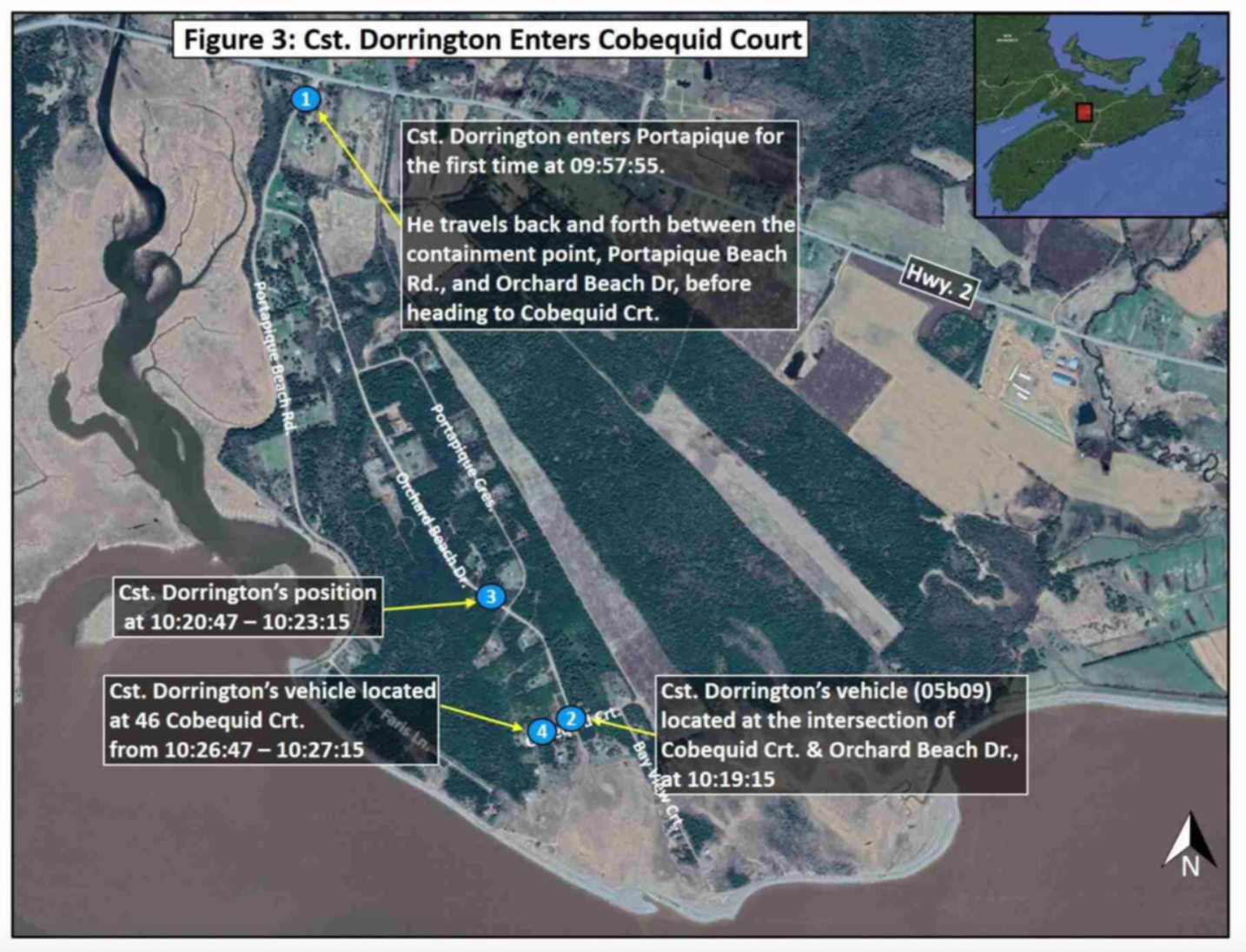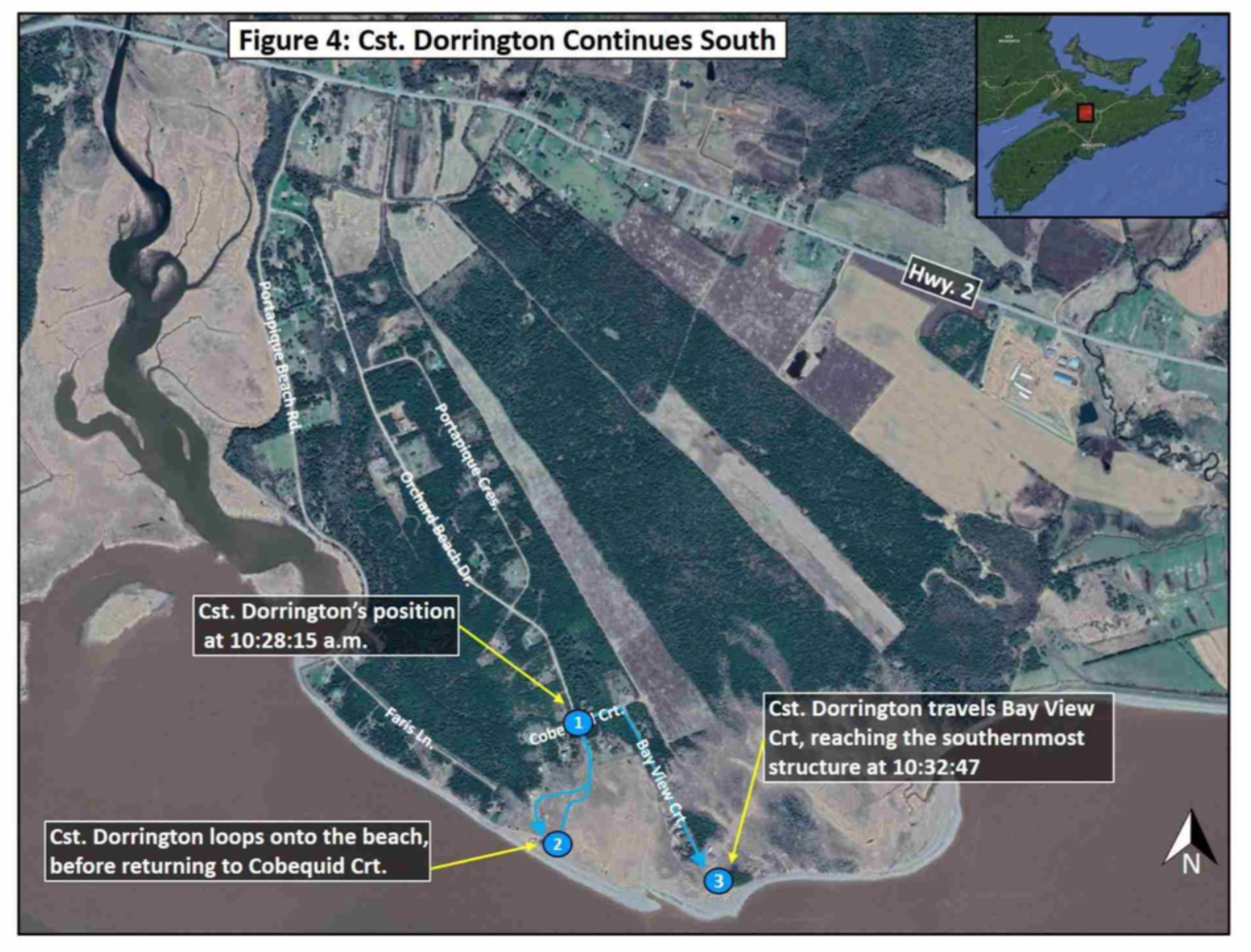The bodies of five victims on the mass murders of April 18/19, 2020 — Joy and Peter Bond, Aaron and Emily Tuck, and Jolene Oliver — were not discovered by the RCMP until 4:45pm on Sunday, April 19, more than 18 hours after they were shot by the killer.
Why the delay?
“It did not occur to me to look for additional [crime] scenes,” said Sgt. Andy O’Brien, who was in charge of containing crime scenes in Portapique for much of the day on Sunday.
There were about 30 houses in the community.
At 9:30am on Sunday, six properties comprised four known crime scenes.
Known crime scene #1: The killer’s warehouse, at 136 Orchard Beach Dr., was burned down. Across the road, at 123 Orchard Beach Dr., was the Blair home; Greg Blair’s body was lying on the deck of the house with a 40mm handgun next to his head, and his wife Jamie Blair’s body was inside in the bedroom. Next door, 135 Orchard Beach Dr., was Lisa McCully’s house; McCully’s body was lying on the yard in front of the house, near a fence post. Corrie Ellison’s body was across the road. These three properties were in essence one crime scene.
Known crime scene #2: Somewhat to the north was the Gulenchyn house at 71 Orchard Beach Dr.; the house was still smouldering. Dawn Madsen and Frank Gulenchyn were unaccounted for, but their bodies were later discovered in the remains.
Known crime scene #3: To the west, at 200 Portapique Beach Rd., was the killer’s burned out cottage.
Known crime scene #4: South of the cottage, at 293 Portapique Beach Rd., was the Thomas/Zahl home, which had burned down and was still smoking; Joanne Thomas and John Zahl were unaccounted for, but their bodies were later found in the remains.
That left about two dozen other houses in Portapique. Unbeknownst to police at 9:30am, there were two additional crime scenes, neither of which had been burned down:
Unknown crime scene #1: The home of Joy and Peter Bond at 46 Cobequid Crt. Peter Bond’s body was in the doorway of the home, propping open the door; Joy Bond’s body was a few feet behind him in the living room. The TV was on.
Unknown crime scene #2: The Tuck home at 41 Cobequid Crt. The bodies of Aaron Tuck, Jolene Oliver, and Emily Tuck were all in the living room of the house. The TV was on.
Officers were stationed at the road block at the intersection of Portapique Beach Road and Highway 2, and at each of the known crime scenes. They were to contain the sites until the Major Crime Unit arrived to investigate, thereby preventing the public from disturbing the scenes and maintaining a chain of custody for whatever evidence might be found at them.
Over the course of the next seven hours, RCMP officers containing Portapique maintained their positions. Cst. Nick Dorrington drove around the community looking for other fires or bodies lying on the roadways or in yards but found none; GPS records show he even pulled into the driveway of the Bond home and stayed there for about 30 seconds, but he didn’t report seeing anything. Staff Sergeant Al Carroll said he too drove around the community (Carroll’s vehicle did not have GPS), including onto Cobequid Court, but saw nothing. O’Brien drove from scene to scene, delivering energy bars and water to officers and covering for them so they could take bathroom breaks. There was a lot of sitting around, doing nothing.
Throughout that seven hours, no one made a systematic check of those other two dozen houses in the community.
Killer reemerges

The fake police car. Photo: Mass Casualty Commission
From about 10:30pm on Saturday night, April 18, until around 4am Sunday, RCMP officers in Portapique were dealing with an active shooter situation — hearing explosions (probably gas and propane tanks exploding at fire scenes) and gunfire (probably ammunition exploding in the fires), they believed the killer was still alive and in the community. In reality, the killer had driven away from Portapique in his fake police car at around 10:40pm .
At around 4am, officers heard what they thought was a single gunshot in the woods and a crisis negotiator at the command post had said the killer was likely “closure motivated” and so he may have killed himself in the woods.
After that, there was a lull in action — officers continued to search for the killer or his body and the Blair family dog was rescued, but there was no evident sense of urgency among police.
Then, at 6:30am, Lisa Banfield emerged from the woods, and explained that the killer had a fake police car. The Emergency Response Team (ERT) was sent to the known crime scenes in Portapique to see if any of the burned out vehicles at those scenes could’ve been the fake police car. They weren’t.
At 7:30am, Halifax police obtained a photo of the fake police car from Banfield’s sister and sent it to the RCMP. Soon after, a BOLO (be on the lookout for) was issued to police across the province; a description of the car was given, and notice that it could be “anywhere in the province.” The public was not alerted.
Beginning at 9:04am, the ERT was slowly evacuating residents in Portapique, starting at the northern end of Orchard Beach Road, and making their way south. Residents were directed to attend a “comfort station” established for evacuees at the Onslow Belmont Fire Hall. Over the next half hour, the ERT made it as far as Richard Ellison’s house on Orchard Beach Road, but not yet to Cobequid Court, along the beach at the south end of the community. Ellison was at the fire hall when it was fired upon by RCMP members.
At about 9:35am, 911 was notified about the killing of Lillian Campbell in Wentworth, at the hands of a man driving what looked like an RCMP cruiser. There was no doubt this was the mass murderer, and so all available RCMP resources were deployed to pursue the killer. Those resources included the ERT and other officers then in Portapique.
With so many officers leaving Portapique, Staff Sgt. Al Carroll was worried about scene crime containment in the community, so he and Sgt. Andy O’Brien travelled from the incident command post in Great Village to Portapique.
“We got out and talked with the guys, repositioned our guys around the site, and we just waited there, we stayed there,” Carroll told Mass Casualty Commission (MCC) investigators on November 10, 2021. “We’re just maintaining the scene, maintaining continuity for any investigative purposes, for further investigation, keeping people out of the scene.”
Carroll put O’Brien in charge of scene containment, and O’Brien made sure there was someone stationed at each known crime scene.
O’Brien did not speak directly with MCC investigators, and he has been granted witness “accommodation” such that his testimony before commission on May 30 and 31 will not be public, nor will he be cross-examined by lawyers representing victims’ families. He did, however, submit written responses to MCC investigators’ questions on January 28, 2022.
“Each scene, or house, at Portapique had a member, with police car, stationed in proximity to the scene,” wrote O’Brien. “That member was responsible for maintaining continuity of the scene, assuring that no one approached the scene and that evidence was preserved. This was accomplished visually, and with foot patrols of the scene, if appropriate. Some scenes were burned out basements that could entirely be observed without moving from one spot.”
“No members were sent to any other locations in Portapique while I was on scene,” continued O’Brien. “I was not aware that there were other scenes. It did not occur to me to look for additional scenes.”
Neither did it occur to O’Brien to continue the evacuation of Portapique that the ERT had abandoned when it left the community to pursue the killer.
Autopsy reports for the Bonds, Tucks, and Oliver show that their injuries were such that they died either instantly or very soon after being shot. But from 9:30am through until 4:46pm, it was still unknown if there were any other victims who may had been injured but not killed, and who therefore needed medical attention. No one was looking for such potential victims, however.
Cst. Nick Dorrington at Portapique
Cst. Nick Dorrington had given a speeding ticket to the killer on February 12, 2020, and as was Dorrington’s practice when issuing a ticket, he took a photo of the killer’s driver’s licence; in the early hours of April 19, that photo was distributed to all police officers.
Dorrington was positioned at Brown Loop when Carroll and O’Brien arrived in Portapique around 10am.
O’Brien repositioned Dorrington and Cst. Trent Lafferty to the Lisa McCully crime scene. Lafferty was to maintain that scene, but O’Brien directed Dorrington “to do kind of a quick drive around Portapique to see if I see anything crazy, if there’s any more fatalities on front lawns, and so forth, and any more structural fires that hadn’t been reported,” Dorrington told MCC investigators in an interview on November 9, 2021. “So I do a quick loop through, nothing in particular, so I return to the first scene that he wanted me to return to and hold [the McCully scene]. So I go there.”

Cst. Nick Dorrington enters Cobequid Court. May: Mass Casualty Commission
GPS data from Dorrington’s vehicle shows he arrived at the intersection of Orchard Beach Drive and Cobequid Court at 10:19:15am, then travelled north to just past the intersection of Orchard Beach Drive and Portapique Crescent, before again travelling south to Cobequid Court.
He turned right, passed the driveway to the Tuck home at 41 Cobequid Court and went to the western end of Cobequid Court, which is at the Bond home at 46 Cobequid Court. Dorrington was positioned in front of the Bond home for 28 seconds, from 10:26:47am to 10:27:15am.

Cst. Nick Dorrington travelled to the southern end of Portapique. Map: Mass Casualty Commission
Dorrington then drove back to the intersection of Cobequid Court and Orchard Beach Drive and south to make a loop around the beach, then back to the same intersection, east on Cobequid Court to Bayview Court. At this point, Dorrington was about 20 metres from the entrance to blueberry field road — which MCC investigators say was the route the killer took to escape Portapique the night before.
Dorrington continued south on Bayview Court to its end, and then reversed himself, again passing the entrance to the blueberry field road on his way to returning to the McCully scene.
Dorrington seems not to have noticed anything wrong with any of the scenes. In his interview with MCC investigators, he was not asked directly about the Bond home or about the blueberry field road. He is not currently scheduled to testify before the commission.
At 1:38pm, Lafferty noticed a man driving near Lafferty’s position at the McCully house. “That problem will be solved in a second,” radioed Dorrington. But O’Brien got on the radio to say that the man lived in Portapique and had stayed through the night; he was going to the store to buy infant formula for his three-month old baby. “I asked him to stay home,” radioed O’Brien.
Staff Sgt. Al Carroll and the blueberry field road

The entrance to the blueberry field road from Cobequid Court. Photo take by Mass Casualty Commission staff on Aug. 23, 2021
In his interview with MCC investigators and again in his sworn testimony before the commission last week, Carroll said that he had driven through Portapique sometime between 10am and noon on April 19, but noticed no other crime scenes.
“I drove down that road [Cobequid Court], there was a nice house on the left-hand side and at the end of that road was an entryway into the blueberry field,” Carroll told MCC investigators. “And that morning, when I was there, I said, ‘Oh, there’s a barrier up.’ There was a chain barrier, a chain or wire across the top, and there was some type of marking thing to identify the chain was there… So, that chain was definitely in place and if that’s the egress point that [the killer] used, I’m saying he would have had to stop, take the chain out, take — take the — take the wire chain off, drive — drive the car through and re— put the chain back in place, put it back up. Otherwise, the height would have cleaned the light bar or anything off the roof of a car.”
Asked about the house he passed, Carroll said that “something tells me that when I was driving down there that I looked up at that house and I thought I saw somebody on the deck. I recall waving at them.”
Carroll didn’t say why he didn’t instruct the person on the deck to evacuate, or why he didn’t send an officer to escort them out of the community.
That house, at 2 Cobequid Crt., belonged to Debra Thibeault. It was immediately adjacent to the entryway to the blueberry field road. Thibeault told MCC investigators that she had permission from the owner of the blueberry field to use the blueberry field road and it was her normal way from Highway 2 to her house. There was a rope — not a chain — across the entryway at Cobequid Court. “We always put the rope back up because it’s private,” she explained.
Thibeault lived alone at her Portapique property, as her husband Peter, who worked for the Navy, wasn’t allowed to live so far from the ships. However, she would often stay with him in Halifax. On Saturday, April 18, 2020, she made a Costco run and then visited with Peter; it was snowing, so she stayed with him overnight. She wasn’t allowed to return to Portapique for several days, as it was a crime scene. Which means, she wasn’t at 2 Cobequid Crt. on Sunday morning, when Carroll said he waved at somebody on the deck.
When Thibealt did return to her Portapique home, she noticed that the gate to the blueberry field had been destroyed.
“I was like, ‘Geez, where’s the posts?'” she said. “And the posts, whoever drove through, broke them in two.”
Thibeault took photos of the broken fence posts, which have been entered as MCC exhibits. She insisted that when she left Portapique on Saturday, April 18, the rope was properly in place.
Carroll’s and Thibeault’s testimony directly contradict each other. Thibeault had several years’ experience with the blueberry field road and the entryway to it at Cobequid Court, and had regularly put the rope back across it. Carroll, for his part, had never seen the blueberry field road or the entryway to it until, he says, he saw it on April 19.
Carroll’s version is uncorroborated by any other evidence or witness accounts. But if his testimony, under oath, were true, it would suggest that the killer did not use the blueberry field road to exit Portapique. And if the killer did not travel out of the community on the blueberry field road then the multiple mapping errors in the early hours of April 19 and Carroll’s failure to recognize the blueberry field road as a potential exit route would not be so significant.
Families worry about their loved ones

Jolene Oliver, Emily Tuck, and Aaron (Friar) Tuck. Photo: GoFundMe
After he learned of the Lillian Campbell murder, Cst. Nick Dorrington texted his wife, Dawn Dorrington.
“I tell her to shelter in place,” Dorrington told MCC investigators in an interview on November 9, 2021. “We have in-laws in the house, and I said, ‘Go down with them and shelter in place. Don’t answer the door.’ My concern was that I was the last one that had contact with him [the killer] and gave him a nice, healthy ticket, and so he’s clearly motivated. You know, he knows that he’s going up for murder and to take out, you know, a cop on the way is nothing to him. So I informed her of that, to shelter.”
It’s unknown if other RCMP officers had contacted their families members, but Dawn Dorrington called her friend Lynn MacKeigan to warn her of the danger, and soon there was an informal text tree of warnings that also reached Sandra McCulloch, a lawyer with Patterson Law, which who now represents many of the victims’ families. On April 19, McCulloch was at home in Elmsdale, outside playing with her kids, not far from the path of the killer.
“I get a text message from a friend at 11:25 telling me of the direction to stay inside and lock doors, and that there was an active shooter in the area,” said McCulloch. “She received a call from a friend of hers who had family who were RCMP members, and they conveyed a private alert to their loved ones.”
“So that’s how I learned of the mass casualty event — not through Twitter, not through Facebook, not through Alert Ready, but because I was lucky to have a friend who had a member of the RCMP as a family member, who was alerting their loved ones.”
Worrying about relatives is an understandably human response. When the public became aware Sunday morning that something terrible had happened in Portapique, people began contacting 911 because they couldn’t reach family members who lived in the community to see if they were safe. Some of those calls were forwarded to RCMP officers in Portapique.
A full accounting of those family calls will be published at a later date by the MCC, but some of the calls are related in a document released last week.
Cst. Nick Dorrington’s handwritten notes record two of those calls asking for well-being checks:
10:20am: Call from Justin to confirm well-being of Parent Elizabeth and Thomas Zahl at 293 Portapique Beach Road (as of 14:40 Justine [sic] still had not heard from either parent.
11:10am: Cheryl Blackie requested a well-being check on Aaron Tuck at 41 Cobequid Court.
Despite that request for a check on Aaron Tuck at his house, his body wasn’t discovered until more than five and a half hours later.

Joy Bond and Peter Bond. Photo: Facebook.
After Cpl. Rodney Peterson passed the killer on Highway 4 without recognizing him, Peterson ended up attending to the scene of the murder of Heidi Stevenson and Joey Webber in Shubenacadie. He was then directed to relieve officers who had been working through the night in Portapique. It’s unclear when Peterson arrived in Portapique, but in the afternoon on Sunday, well-being calls were forwarded to him.
Peterson’s written report shows that he received a call at 3:11pm from Tara Long, who was looking for her brother, Aaron Tuck, who lived at 41 Cobequid Court.
“Apparently her brother lived in Portapique and she couldn’t get a hold of him,” Peterson later told MCC investigators. “At that time, I knew a lot of people had been diverted from Portapique, the residents, to the fire hall or something like that as like a comfort zone… And so I said, ‘Well, he might be there, you know, I don’t know for sure.’ I got his name and whatnot. So from there, I contacted a corporal down and working… I called him up and he says, ‘Yeah, I can’t do it right now… I’m the only one here at my post.'”
At 3:50pm, Peterson received a call from Rebecca MacKay, who also wanted a well-being check. It’s unclear who MacKay was asking about.
Peterson was annoyed by the calls. He called dispatch to complain.
“I said, ‘Listen, you know, I don’t think we should be taking these calls,” said Peterson. “We’re trying to do things out here. Is there any way somebody else can take these calls?”
After that, well-being calls were taken by Cst. Dave Lilly at the dispatch centre.
Finally, at 4:46pm, Cpl. Jarrett MacDonald had the time to check on the Tuck home at 41 Cobequid Crt., which Peterson had told him about an hour and a half before. But MacDonald went to the wrong house — he arrived at 46 Cobequid Crt., the Bond home. He discovered the body of Peter Bond in the doorway, and saw Joy Bond dead behind him.
MacDonald then went to the correct address and discovered the bodies of Aaron Tuck, Jolene Oliver, and Emily Tuck.
Only then did RCMP officer begin checking other residences in Portapique.
Subscribe to the Halifax Examiner
We have many other subscription options available, or drop us a donation. Thanks!
Adblock test (Why?)
Bodies of five murder victims weren't discovered by the RCMP for more than 18 hours after they were killed - Halifax Examiner
Read More
:format(jpeg)/cloudfront-us-east-1.images.arcpublishing.com/tgam/C2DVLQCAIFN47D2G7Y6FRAMV6Q.jpg)





















